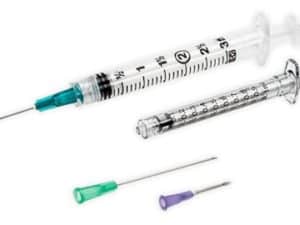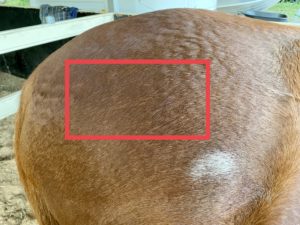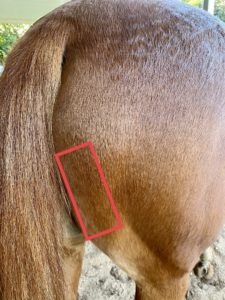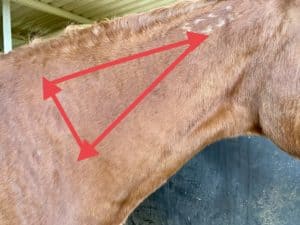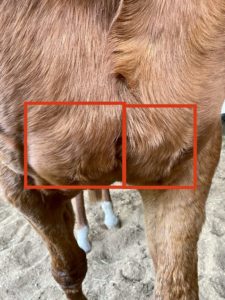What is the difference between IM (Intramuscular) & IV (Intravenous) Injections?
Your veterinarian has recommended that your horse have medication given via an injection. This means that medication is given through a needle and syringe.
There are many different reasons why your veterinarian may recommend giving your horse injections including:
- Treating an illness;
- Sedation;
- Chronic pain management;
- Routine vaccinations.
The route of administration of an injectable may also vary for different reasons including:
- Temperament: Some horses prefer different routes of medication.
- Type of Medication: Some medications can only be given by a particular route.
- Urgency: Giving a drug IV works more quickly than IM.
- Cost
- Experience and confidence of handler
- Whether the drug needs to have a local effect on the body or affect the whole body
Some things to remember when giving an injection:
- Always use a new needle and syringe. New needles are sharp and cause less pain and damage to the area and new syringes prevent infection.
- Always disinfect the tops of medication bottles if you are using them more than once. Do not let bottles get dusty or dirty.
- Always clean and disinfect the area on the horse to be injected before and after injecting to prevent infection.
- Insert needles with firmness and purpose. Try not to jab or stab as this can scare the horse.
- Always monitor the injection site for any heat or swelling that may occur after and inform your veterinarian as soon as possible if it does.
- Try to make the event as pleasant as you can. Give treats for good behaviour if possible and lots of pats and cuddles. It is very easy to create a needle shy horse.
IM (Intramuscular) Injections
IM (Intramuscular) injections are where the medication is injected directly into a muscle. IM injections are often recommended when a drug needs to be released slowly into the body like drugs used to treat joint disease and antibiotics. Common medications that are given IM are vitamins and minerals such as Ranvet’s Batphol, Macrofol, and Foliphos; antibiotics, vaccines, steroids, and joint treatments.
There are quite a few areas of the horse that are used to inject into the muscle. The neck is a popular area for vaccinations. Injecting more than 10mls into this area can cause soreness though and abscesses are difficult to treat in this area, so it is not the best area to use for large volumes such as penicillin. If you do use this area for large volumes, just be careful to clean and disinfect the area well with alcohol before and after each injection and always use a new needle and syringe. The top of the hip or gluteal muscles is a good area for large volumes but again is very difficult to treat if an abscess occurs as there is nowhere for the infection to drain. The preferred location for large volumes of medication such as penicillin is in the upper rear legs just on either side of where the dock of the tail ends. These muscles are called the semimembranosus & semitendinosus. They are very large muscles and due to their location will easily drain in the rare chance of an abscess. This area can be very dangerous to inject if your horse is needle shy, so always stand to the side while injecting this area and be careful. The pectoral muscles in the chest can be used as well but this area seems to be prone to swelling when injected. It is very easy to treat if an abscess forms though, as it drains well. I like this area for small volumes such as steroids or treatment for joints if I want to give the bum a break from needles.
Intramuscular injection sites:
To administer an IM injection first clean and swab the area with alcohol. The needle is then firmly inserted straight into the area up to the hub of the needle. If any blood appears, pull the needle out halfway and redirect into a different spot. Firmly but gently attach the syringe to the hub of the needle and pull back to make sure there is no blood. Slowly but firmly inject half the contents and then check again to make sure there is no blood that can be pulled back into the syringe. Always redirect the needle if you ever see blood, injecting some medications like penicillin into a vein can cause serious reactions. Inject the rest of the contents of the syringe and swab the area after removing the needle. Always try not to wiggle the needle while injecting to reduce causing pain and injury to the muscle.
Click here to see IM Injection demonstration
IV (Intravenous) Injections
IV (Intravenous) injections are where the medication is injected directly into a vein (not an artery!). IV injections are usually recommended when drugs need to be absorbed into the body quickly. Other reasons may include when a drug would be irritating to body tissues if given by another route or would be poorly absorbed. Common drugs that are given IV are: vitamins & minerals such as Ranvet’s Foliphos (can also be given IM or SC (subcutaneous)), sedation, and fluids for rapid rehydration such as Ranvet’s Lang’s Solution.
The most frequently used veins for IV use in horses are the jugular veins on either side of the neck. Other veins can be used if needed, but it is not common. To administer an IV injection the area is first cleaned and then swabbed with alcohol. Next you put pressure on the vein with your finger just below where you will insert the needle to make it more visible to inject. The needle is then inserted into the vein at an angle without the syringe to ensure that you are in a vein and not an artery. Venous blood will “ooze” or “drip”and arterial blood will “spurt” or “pulse”. This is very important as you can kill a horse my injecting the wrong drug into an artery. Gently remove the needle halfway and redirect if you are in the wrong spot. Next the syringe is checked and any air bubbles removed, and then it is firmly but gently attached to the needle. Once the syringe is attached, pull some blood back into the syringe to make sure it is still in the vein and then release your finger from the vein and inject the drug. Withdraw the needle and put pressure over the area with a swab if there is any bleeding till it stops.
Experts in Equine Nutrition
Every product in the Ranvet range has been developed to meet a horse’s most specific need at any given time, be it in a training environment or on a breeding farm. Having pioneered the formulation of specific medications and dietary supplements for horses, the company is now recognised as a leader in the areas of equine health and nutrition.

